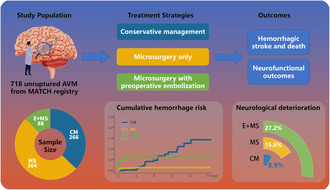- Record: found
- Abstract: found
- Article: found
Comparison of conservative management, microsurgery only, and microsurgery with preoperative embolization for unruptured arteriovenous malformations: A propensity score weighted prospective cohort study

Read this article at
Abstract
Aims
To compare the efficacy and deficiency of conservative management (CM), microsurgery (MS) only, and microsurgery with preoperative embolization (E + MS) for unruptured arteriovenous malformations (AVMs).
Methods
We prospectively included unruptured AVMs undergoing CM, MS, and E + MS from our institution between August 2011 and August 2021. The primary outcomes were long‐term neurofunctional outcomes and hemorrhagic stroke and death. In addition to the comparisons among CM, MS, and E + MS, E + MS was divided into single‐staged hybrid and multi‐staged E + MS for further analysis. Stabilized inverse probability of treatment weighting using propensity scores was applied to control for confounders by treatment indication across the three groups.
Results
Of 3758 consecutive AVMs admitted, 718 patients were included finally (266 CM, 364 MS, and 88 E + MS). The median follow‐up duration was 5.4 years. Compared with CM, interventions (MS and E + MS) were associated with neurological deterioration. MS could lower the risk of hemorrhagic stroke and death. Multi‐staged E + MS was associated with neurological deterioration and higher hemorrhagic risks compared with MS, but the hybrid E + MS operation significantly reduced the hemorrhage risk.
Abstract
Related collections
Most cited references43
- Record: found
- Abstract: found
- Article: not found
The Strengthening the Reporting of Observational Studies in Epidemiology (STROBE) statement: guidelines for reporting observational studies.
- Record: found
- Abstract: found
- Article: not found
Sensitivity Analysis in Observational Research: Introducing the E-Value.

- Record: found
- Abstract: found
- Article: found
